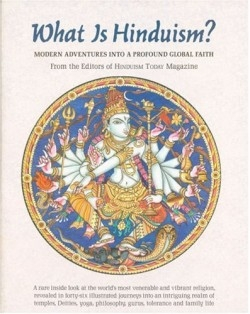
What Is Hinduism
Modern Adventures into a Profound Global Faith
Hinduism is the largest and oldest religion on earth—almost 5,000 years old. More than a billion people are followers of India’s “eternal faith.”
Religion is a way of life in India, where Hinduism is practiced by over eighty percent of the population. But why is it that people don’t really have a good answer when asked, What is Hinduism? Stereotypical or uninformed answers might include: Hindus practice non-violence. Or, they paint marks on their foreheads. Or even, they worship the cow (untrue, they just adore them).
It is difficult to define Hinduism because the Western world has a different awareness of what living a religious life means. “The Hindu is conscious that life is a precious, fleeting opportunity to advance, to bring about inner transformation, and he strives to remain ever conscious of this fact. For him work is worship and his faith relates to every department of life.” In the Western world a personal spiritual life is different than religion. Religion is practiced on Sunday mornings, or weekend masses.
Even more ambiguous is Hinduism’s diversity; it happily envelops any and all other religions. “It is accurately a conglomeration, union, a family, of many different faiths and practices that share essential characteristics.” It does not focus on any single god such as Christ or Buddha, or a single system of beliefs or doctrine; it is a complexity unified under one umbrella called Hinduism.
There are ways to narrow it down. Hinduism has four primary denominations: Vaishnavism, Saivism, Shaktism, and Smartism. Within them are thousands of sects. And within those sects there are gurus and their lineages; there are vast numbers of sacred writings and scriptures, including the well-known Vedas, and the Bhagavad-Gita. There are spiritual songs, poems, mantras, and philosophies. Not to mention the hundreds of deities.
Each Hindu does believe in the Supreme Being—One who is called by different names depending upon what path is being followed. For example, Lord Vishnu is worshipped by the Vaishnavites, and then there’s Siva, Shakti, etc. The darling of the deities is the popular elephant-faced Lord Ganesh. Hindus believe “truth is one, paths are many.”
The editors of Hinduism Today magazine have gathered articles from more than ten years of publication and harmonized them into this book. It is an entertaining mix of hip, modern, and traditional information about the world of Hinduism. The content is divided into six sections: The Nature of Hinduism, Hindu Metaphysics, How Hindus Worship, Spiritual Practices, Family Life and Culture, and Hindu Ethics. For children, “Hinduism from A to Z,” is an illustrated alphabet designed as twenty-six mini-lessons on Hindu thought and culture. Other features include comparisons with various religions, sacred art and architecture, yoga, the chakras, the human aura, and cartoons. In-depth articles, summary pieces, colorful quick facts—the material appeals to a variety of seekers. Hundreds of cultural photographs and rich artwork frame and fill each page.
A young man seeking a way of life stated, “I’d like a path that is as spacious as the universe…a path that includes everyone and every possible belief system.” That path was Hinduism: a religion that is lived and experienced on a daily basis, held strong in the heart, and is open to all who have a desire for spiritual growth.
The three pillars of practicing this religion—a guru-devotee relationship, studying the scriptures, and worship—help define the Hindu lifestyle. A guru is someone who mentors and helps devotees along their chosen path. The spiritual writings impart wisdom, guidance, and transformation. Hindus have a tradition of going on pilgrimages to temples of specific deities; this is a joyous occasion, a chance to relinquish old burdens and move forward in life. There is much communion, celebration, and oneness within the culture.
What Is Hinduism? is a lush repository; it will appeal to all ages and especially those looking for clarity and insight.
About that dot on the forehead, the “Ten Questions People Ask about Hinduism” says this: “It is a religious symbol representing divine sight and shows that one is a Hindu. For women, it is also a beauty mark.” Now, there’s nothing confusing about that.
Reviewed by
Aimé Merizon
Disclosure: This article is not an endorsement, but a review. The publisher of this book provided free copies of the book to have their book reviewed by a professional reviewer. No fee was paid by the publisher for this review. Foreword Reviews only recommends books that we love. Foreword Magazine, Inc. is disclosing this in accordance with the Federal Trade Commission’s 16 CFR, Part 255.
